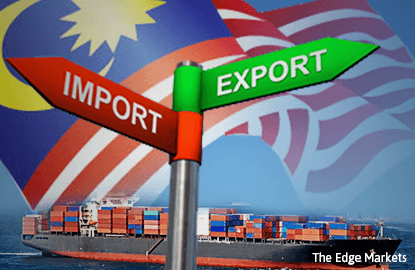
KUALA LUMPUR (Nov 6): Malaysia’s exports in September 2015 rose 8.8% to RM70.2 billion, from RM64.5 billion a year ago, the Department of Statistics said, surpassing the Bloomberg consensus forecast for 3.3% growth.
On a month-on-month basis, exports were up by 5.5% from August’s RM66.5 billion, or 5.2% when seasonally adjusted.
Total imports in September 2015 also grew 9.6% to RM60.5 billion, from RM55.2 billion in September 2014. Economists polled by Bloomberg estimated the growth to come in at 3%.
This brought total trade to RM130.6 billion.
Trade surplus, or the difference between exports and imports, totalled RM9.7 billion, which was 4.1% or RM381.2 million, from a year earlier. However, it fell 4.6% or RM471.7 million from the previous month.
According to the Department of Statistics, the main products contributing to the export growth were electrical and electronics (E&E) products, timber and timber-based products, and natural rubber.
E&E, which made up 37.2% of total exports, grew 13.6% or RM3.1 billion to RM26.1 billion. Timber and timber-based products, making up 2.8% of total exports, rose 14.5% or RM252.9 million to RM2 billion, while natural rubber rose 20.1% year-on-year to RM367.7 million, due to the increase in both export volume and average unit value.
As expected, there were declines in crude oil based products and derivatives. Liquefied natural gas dropped by a third or RM1.7 billion year-on-year to RM3.4 billion, due to drops in average unit value and export volume.
While refined petroleum products’ export volume rose 20.2%, there was still a 4.7% decline in the products’ total exports to RM3.3 billion, because of a 35.1% fall in average unit value.
Meanwhile, crude petroleum decreased 12.2% or RM346.8 million to RM2.5 billion, and palm oil and palm-based products fell RM202.9 million or 3.3% to RM6 billion.
“Exports of palm oil, the major commodity in this group of products, fell RM373.0 million or 8.7% and this was attributed to the drop in both export volume, by 6.8%, and average unit value, by 2%,” said the Department of Statistics.
As for imports, the contributing factors to their growth were the rise in capital goods and consumption goods.
Capital goods, making up 14.8% of total imports, grew by RM2.1 billion or 29.9% to RM9 billion.
Consumption goods, meanwhile, rose 43.2% to RM5.7 billion, with major contributors to the growth being semi-durables; food and beverage, processed, mainly for household consumption; and non-durables.
However, intermediate goods, which made up 54% of total imports, decreased by 6.5% to RM32.7 billion. The Department of Statistics said the fall in this component of goods was mainly due to industrial supplies, processed; fuel and lubricants, primary; and fuel and lubricants, processed, others.
Adding September’s trade figures into the equation, Malaysia’s total trade so far this year amounted to RM1.08 billion.
China remains as the biggest trade partner, making up 15.7% of the total trade year-to-date. Trailing behind was Singapore at 13% and the European Union bloc at 10%.
Total exports year-to-date was RM568.2 billion, while total imports came to RM504.3 billion — indicating the trade surplus at roughly RM63.9 billion. China was the biggest consumer of Malaysia’s exports, making up 18.7% of the total figure. It was also the biggest importer to Malaysia, at 13.1%.